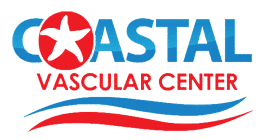FAQ: Varicose & Spider Veins
Coastal Vascular Center is your medical center for answers on varicose & spider veins. Our page here is dedicated to answering some of our more common questions on vein reflux. If you have any concerns or want to speak with a doctor, give us a call today!
What are varicose and spider veins?
The enlarged, threadlike veins known as varicose veins are visible outside the skin’s surface. They can be flesh-colored, dark purple, or blue and often look like a cluster of grapes. Varicose veins are most commonly found on the back of calves or the inside of legs but can form anywhere on the legs from groin to ankle.
Spider veins are smaller and closer to the surface of the skin than varicose veins. They are often red or blue and look like tree branches or spider webs. They can occur anywhere on the legs, covering either a very small or very large skin area. Unlike varicose veins, they do not bulge; instead, they are more noticeable because they are closer to the skin’s surface.
You can learn more about the differences between Spider and Varicose veins on our blog
What causes varicose veins?
Varicose veins are caused by abnormal inner walls or defective valves in the body’s blood vessels. The arteries carry blood from the heart to the rest of the body, and veins return blood to the heart through the venous system. Valves in veins act as one-way flaps, preventing blood from backing up and pooling. When these flaps do not function properly, blood then may flow backward causing veins to dilate (enlarge) and become varicose. The technical terms for this condition are venous reflux or venous insufficiency.
How common are varicose veins and spider veins?
More than 80 million Americans suffer from the disease of veins. About 50-55% of women and 40-45% of men suffer from some form of vein problem. Varicose veins affect 1 out of every 2 people older than the age of 50.
Will diet affect my varicose veins?
Yes. A diet rich in fruits and vegetables, as well as fiber-rich foods such as whole grains, will improve your general health and the health of your veins. For example, salty foods put greater pressure on veins by encouraging water retention. Similarly, dairy and red meat minimize consumption of foods that can worsen varicose veins by promoting constipation like another source of excessive pressure on veins.
Who is at the highest risk of developing varicose veins?
While varicose veins affect both men and women, women are at a higher risk of developing them. Pregnant women are particularly prone to the condition. It’s also true that 42% of men develop venous insufficiency by age 60. Having a family history of varicose veins puts you at increased risk for developing them.
What are the risk factors for varicose veins and spider veins?
Common risk factors for varicose and spider veins include:
- Increasing age
- Family history
- Pregnancy and hormonal changes
- Obesity
- Prolonged standing
- Prior deep venous thrombosis
What are the signs and symptoms of varicose veins?
Varicose and spider veins often cause no symptoms. However, unattractive veins can be painful and are more likely to develop when a person sits or stands for long periods. Some common symptoms of them include:
- Aching pain
- Itching
- Burning
- Leg swelling
- Easily tired legs
- Numbness in the legs
- Leg heaviness
- Darkening of the skin
- Rash on the legs
- Skin ulcers
Learn more about symptoms of varicose veins in our linked article.
Can spider veins turn into varicose veins?
Some people confuse varicose veins with spider veins, but the two conditions are not related. Spider veins are much less severe; although they may be more visible or darker than normal veins, they rarely protrude as significantly as varicose veins and are usually less painful.
Do compressions stockings treat varicose veins?
Compression stockings are a highly effective treatment for patients with varicose veins or another chronic venous insufficiency. They stimulate blood flow in the afflicted veins and prevent blood from accumulating, reducing inflammation. However, compression stockings should be worn only as part of a treatment plan developed by a doctor, and you should always ask a doctor about which type of stocking is right for you.
When should I talk to a doctor about my varicose veins?
Self-help measures (conservative therapy) can help ease the pain of varicose veins and may prevent them from worsening. But if the way they look and feel becomes a concern or if self-help measures are not successful, then it’s time to see a doctor.
What will happen if I leave my varicose veins alone?
Left untreated, varicose veins can result in sores, ulcers, blood clots, and deep vein thrombosis. It’s best to treat varicose veins as soon as possible to avoid these costly and potentially life-threatening complications.
We go into more detail about leaving varicose veins untreated in our linked article.
How are varicose and spider veins treated?
The treatment for venous reflux (backflow) and varicose veins depends on the type of vein problem and your specific needs. Dr. Ayar will recommend a treatment plan based on your consultation and ultrasound evaluation.
We discuss laser therapy for varicose veins in our linked article.
Frequently Asked Questions
Book An Appointment
Other Services
